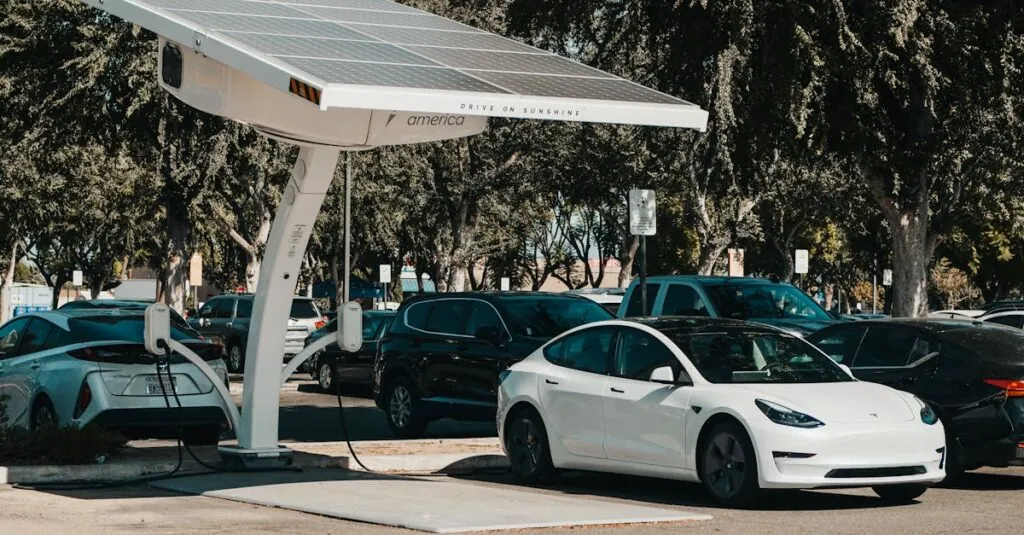Imagine a world where charging your devices is as easy as breathing. Forget about tangled cords and frantically searching for an outlet. Plugless charging is here to save the day, transforming the way we power up our gadgets. It’s like magic, but without the rabbits and top hats.
This innovative technology uses electromagnetic fields to charge devices wirelessly, making it not just convenient but also a little futuristic. Whether it’s your smartphone, electric toothbrush, or even your car, plugless charging promises to eliminate the hassle of plugging in. So why not embrace this tech wonder and step into a world where charging is effortless? After all, who wouldn’t want to live in a reality where the only thing they need to do is set their device down and walk away?
Table of Contents
ToggleOverview of Plugless Charging
Plugless charging represents a significant advancement in how devices obtain power. This technology utilizes electromagnetic fields to transfer energy wirelessly, allowing for seamless charging experiences. Users no longer contend with tangled cords or hunting for outlets; they simply place their devices on a designated charging surface.
Electric vehicles stand out as a key application of this innovation. Wireless charging pads embedded in parking spaces enable cars to charge automatically when parked. Convenience increases significantly, promoting a smoother transition to electric mobility. Studies show that charging can be even faster with this method compared to traditional plug-in systems.
Smartphones and wearables also benefit from plugless charging. Consumers can charge their devices by merely placing them on compatible surfaces, enhancing usability. Industry leaders, like Apple and Samsung, incorporate this technology into their product lines, signifying a trend toward widespread adoption.
Medical devices utilize plugless charging for improved safety and reliability. Removing wires reduces the risk of contamination in hospitals, allowing for sterile charging environments. This application improves patient care by ensuring devices remain charged without manual intervention.
Environmental impact deserves attention too. Plugless charging systems often increase energy efficiency, minimizing energy loss during the transfer process. Optimizing energy consumption supports sustainability goals while maintaining high-performance levels.
Overall, plugless charging transforms the way people interact with their devices. As adoption grows across various sectors, the future of wireless power looks promising, simplifying life for users everywhere.
How Plugless Charging Works
Plugless charging employs electromagnetic fields to transfer energy wirelessly. This innovative approach simplifies the charging process by eliminating cumbersome cables.
Inductive Charging Technology
Inductive charging technology serves as the backbone of plugless charging systems. This method relies on two coils: a transmitter coil located in the charging pad and a receiver coil within the device. When the transmitter generates an electromagnetic field, the receiver coil captures the energy and converts it into usable power for the device. Studies show that this transfer can occur at rates equal to or exceeding traditional plug-in chargers. By employing resonant inductive coupling, these systems achieve greater efficiency and flexibility in positioning.
Components of a Plugless Charging System
A plugless charging system consists of several essential components. The charging pad features a transmitter coil and often includes a power control unit to manage energy flow. Devices equipped with receiver coils depend on compatible technology to ensure seamless communication with the charging pad. Safety features protect against overheating and ensure energy transfer only occurs when a device is present. Furthermore, user interfaces on many systems provide feedback, allowing users to know charging status at a glance. Together, these components create a reliable, efficient charging experience.
Advantages of Plugless Charging
Plugless charging offers numerous benefits that enhance the user experience and promote efficiency. Its innovative design favors convenience and security.
Convenience and Ease of Use
Charging becomes effortless with plugless technology. Wireless charging pads eliminate the hassle of tangled cords. Users simply place devices onto the pad for instant power access. This system is particularly beneficial for smartphones and electric vehicles. Convenience extends to wearables, which charge without the need for plugs. Embedded charging pads in parking spaces streamline the process for electric vehicles. Daily interactions with devices turn frictionless, making it easier to maintain a charged battery.
Enhanced Safety Features
Safety significantly improves with the use of plugless charging. The removal of physical connections minimizes the risk of electric shocks. Contamination risks are reduced in environments like hospitals, where hygiene is critical. Devices maintain their functionality without manual plugging and unplugging, preventing wear and tear. Built-in safety features help protect against overheating, ensuring user confidence. Feedback mechanisms provide real-time charging status updates, making it easier to monitor power levels. Enhanced safety alongside convenience makes plugless charging a reliable choice for various applications.
Challenges Facing Plugless Charging
Plugless charging introduces challenges that affect its widespread adoption. These obstacles include high costs and integration difficulties, along with compatibility concerns.
Cost and Implementation Issues
Implementing plugless charging systems often requires significant financial investment. Initial costs for infrastructure, such as charging pads and receiver coils, can deter businesses and consumers. Integrating this technology into existing sites like homes, public spaces, and parking lots demands additional resources. Infrastructure compatibility issues can arise, necessitating upgrades to electrical systems. Long-term benefits might not justify short-term costs for some stakeholders. However, as technology advances, prices for components are expected to decrease, potentially increasing accessibility.
Compatibility with Existing Electric Vehicles
Existing electric vehicles face challenges when integrating plugless charging technology. Many current models do not support wireless charging features, requiring manufacturers to develop new compatible designs. Compatibility issues can complicate standardization efforts across automakers. End users may hesitate to invest in vehicles that lack wireless functionality. To foster adoption, manufacturers must collaborate for unified standards. Newer models are starting to incorporate this technology to stay competitive. As more vehicles become designed for this charging method, greater market acceptance is likely.
Future of Plugless Charging
Emerging trends indicate a promising future for plugless charging technology. As various sectors adopt this innovation, significant advancements are expected in device compatibility and efficiency.
Innovations on the Horizon
Innovations continue to reshape plugless charging options. Researchers explore resonant inductive coupling, enhancing energy transfer rates for efficiency. Companies invest in improving safety mechanisms, ensuring devices operate without overheating. Additionally, developers focus on miniaturization, allowing for smaller and more portable charging solutions. Wireless power transfer systems are likely to integrate with smart home devices, enabling automatic charging when devices enter a specific range. With advancements in materials, energy transfer losses may decrease, promoting environmental sustainability.
Potential Market Growth
Market growth opportunities for plugless charging are substantial. Statista projects that the global wireless charging market will reach approximately $37 billion by 2025. Factors driving this growth include increased consumer demand for convenience and advancements in electric vehicle technology. Automakers are likely to prioritize the integration of wireless charging capabilities in newer models, responding to market trends. Furthermore, the healthcare sector is expected to adopt plugless systems for medical devices, enhancing operational efficiency. As awareness and acceptance continue to rise, plugless charging could become the standard for device charging in households and businesses worldwide.
Plugless charging is set to redefine how devices are powered in the modern world. Its convenience and efficiency promise to enhance user experiences while reducing the clutter of cords. As the technology matures and costs decrease, more consumers and businesses will likely embrace this innovative approach.
The potential for plugless charging to integrate seamlessly into everyday life is immense. With advancements in compatibility and safety, it stands to revolutionize not just personal devices but also electric vehicles and medical equipment. As awareness grows and industry standards develop, the future of wireless charging looks bright, paving the way for a more connected and efficient world.





